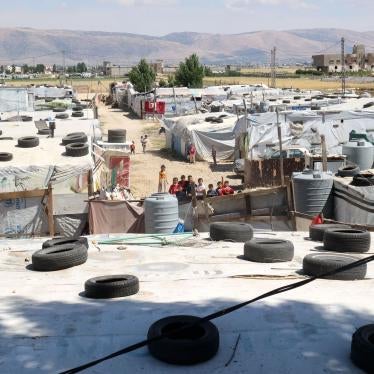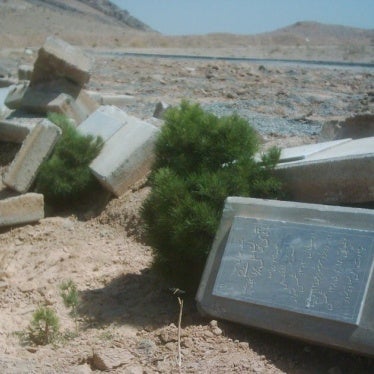The way a government or armed group responds to a Human Rights Watch report says a lot about its willingness to curb abuses. Does it grapple seriously with the findings or simply dismiss them? Human Rights Watch encountered a bit of each when we recently released reports on why civilians died during Israel's 2006 war with Hezbollah.
Our report on Hezbollah's rocket attacks on northern Israel addressed Hezbollah's two asserted justifications: that it was aiming only at military targets and, somewhat contradictorily, that insofar as it targeted civilians, it was in reprisal for Israeli misconduct. Human Rights Watch's detailed investigation in northern Israel demonstrated that while at times Hezbollah did aim at military targets, frequently it aimed at civilian areas with no military target in sight. The report also emphasized the laws-of-war prohibition of attacks against civilians for any reason, even as ostensible reprisal.
Hezbollah did not want people to hear this message. Calling Human Rights Watch a "biased organization," its Al-Manar television station rallied its supporters to protest outside the Beirut hotel where we had planned to hold a press conference to release the report, forcing the hotel to cancel the event. A lawyer sympathetic to Hezbollah even convinced a prosecutor to investigate the Human Rights Watch researcher in Beirut for treason. The report still got massive press attention - all the more so as "the report that Hezbollah tried to censor" - but Hezbollah's response hardly showed a willingness to correct its lawless ways.
A week later, I released the Human Rights Watch report on Israel's conduct during the war at a press conference in Jerusalem (which was not canceled). Human Rights Watch researchers had spent five months in southern Lebanon, examining 94 attack sites representing roughly half of civilian deaths. We found that, contrary to the Israeli government's claim, the primary reason for civilian deaths was not that Hezbollah fired rockets from civilian areas. Sometimes that happened, as various videos and photographs have shown, but it was exceptional. Far more frequently, Hezbollah fired rockets from the well-fortified bunkers that it had spent the previous six years building in the hills and valleys outside of villages.
Instead, Lebanese civilians died from Israeli bombing mainly because the Israel Defense Forces took insufficient care to distinguish civilians from combatants as required by the laws of war. The IDF rightly warned civilians to flee southern Lebanon. Many did, but as the IDF knew, many others remained because they were too old or infirm to flee, too poor to pay exorbitant taxi fares charged for evacuation, or too fearful to take to the frequently bombed roads.
Nonetheless, the IDF often proceeded to attack as if there were no civilians left in southern Lebanon. It frequently assumed that people driving in vehicles or moving outside their homes were combatants, even though the activity was consistent with civilian life. Hundreds of civilians needlessly died as a result.
Faced with this troubling evidence, even the IDF was reluctant to confront the facts. The top IDF lawyers with whom we met noted several times that, unlike Hezbollah, the IDF did not deliberately try to kill civilians. But of course, the laws of war, not Hezbollah, provide the proper measure for Israeli conduct. The lawyers noted, correctly, that the IDF was under intense political pressure to end the Hezbollah rocket barrage on northern Israel, but it is precisely such difficult circumstances for which the laws of war are intended.
The lawyers said that witnesses in southern Lebanon might have lied about the absence of Hezbollah fighters in the vicinity of civilians killed by Israeli bombardment. But Human Rights Watch credited witnesses only after extensive corroboration involving interviewing them alone at a level of detail that would have been extremely difficult to fabricate. Moreover, their testimony was supported by what we found at graveyards, where it was easy to distinguish civilians from combatants because only the fighters were honored as "martyrs." The graveyards showed that the 100 or so fighters killed by Israeli bombardment tended to die in clusters without civilians present, while civilians usually died without fighters among them, as the witnesses had reported.
Finally, as a trump card, the IDF claimed that it had secret intelligence justifying the attacks. But whatever that evidence, Human Rights Watch's investigation shows that the conclusions the IDF drew were repeatedly wrong - the supposed military targets were in fact, again and again, only civilians.
By sending researchers to southern Lebanon, Human Rights Watch has produced evidence about the conduct of the war that would otherwise have been unavailable to the IDF. The IDF should weigh that evidence against its secret intelligence - and recognize that its threshold for concluding that Hezbollah fighters were present at a particular site was set far too low. Correcting that deadly practice is essential if, in future wars, Israel is not to be responsible once more for needlessly killing civilians.
The writer is the executive director of the international human rights organization Human Rights Watch.








